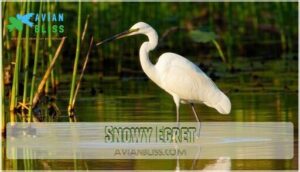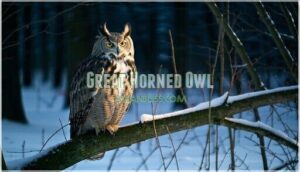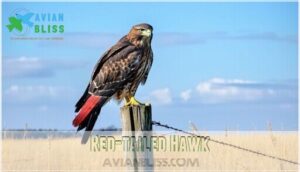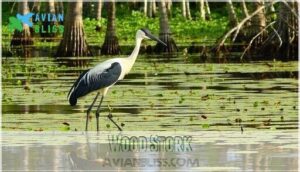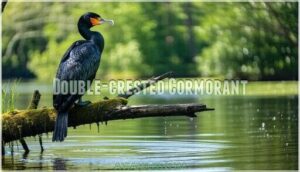This site is supported by our readers. We may earn a commission, at no cost to you, if you purchase through links.
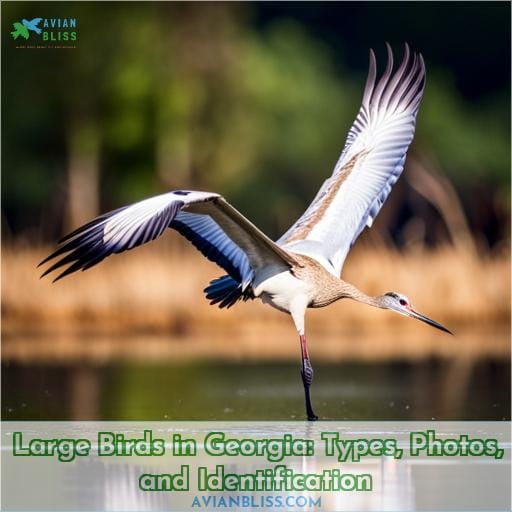 Are you curious about the large birds that can be found in Georgia? With its diverse habitats, the Peach State is home to a wide variety of feathered creatures. From bald eagles to red-tailed hawks and great horned owls, there are plenty of fascinating avian species with impressive wingspans throughout Georgia.
Are you curious about the large birds that can be found in Georgia? With its diverse habitats, the Peach State is home to a wide variety of feathered creatures. From bald eagles to red-tailed hawks and great horned owls, there are plenty of fascinating avian species with impressive wingspans throughout Georgia.
Table Of Contents
Key Takeaways
- Diverse large bird species in Georgia.
- Prominent raptors like Bald Eagles and Red-tailed Hawks.
- Great Horned Owls with distinctive features.
- Great Blue Herons frequent marshes.
Types of Large Birds in Georgia
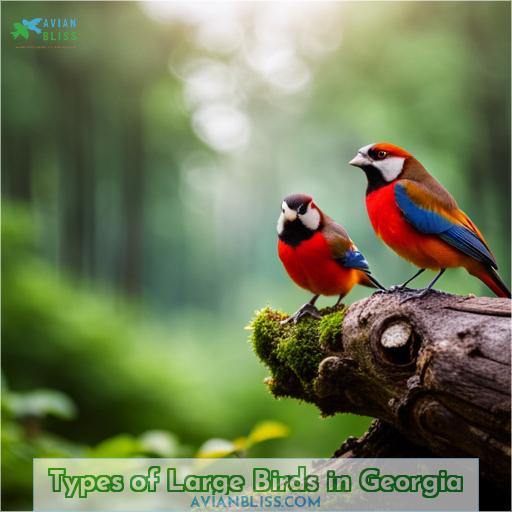
You’ll spot distinctive raptors like the Bald Eagle and Red-tailed Hawk in Georgia’s diverse landscapes. The Bald Eagle, a symbol of strength and majesty, thrives year-round along the southeastern coastline.
These powerful birds of prey favor lakes, reservoirs, and lush forests. Their carnivorous appetite leads them to hunt other birds, medium-sized mammals, reptiles, fish, and carrion.
The Great Horned Owl, with its hooting calls and striking orangey face, is a year-round resident in Georgia. These nocturnal hunters venture out at night, preying on smaller animals such as rodents and other birds.
Meanwhile, the Great Blue Heron, known for its elegant stature, frequents marshes, ponds, shores, and mud flats during breeding seasons.
Turkey Vultures, with their keen sense of smell, are abundant throughout Georgia. They play a crucial role in nature’s cleanup crew, locating carrion for their meals.
Finally, the Red-tailed Hawk, with its distinctive red tail, is a common resident that inhabits diverse areas like deserts, grasslands, forests, and even urban spaces. They feed on small mammals, rodents, other birds, fish, and carrion, showcasing their adaptability in Georgia’s varied habitats.
Great Egret
Friend, great egrets are easily spotted stalking through Georgia’s marshes and ponds during breeding season, thanks to their snowy white plumage, despite their wish that we walk a mile in their wings.
Great egrets inhabit Georgia’s marshes, ponds, mud flats, and shores while breeding during spring and summer months. They build platform nests in trees or shrubs near water sources, where they lay three to four eggs.
As waders, great egrets spear fish, crustaceans, amphibians, insects, and small mammals with their long, sharp bill.
Migrating from further north, these birds frequent Georgia for nesting and raising young before returning to overwintering grounds.
Though common, great egrets face threats like habitat loss and are protected under the Migratory Bird Treaty Act.
Snowy Egret
Seeing as how Snowy Egrets breed in southern and central Georgia, you’ll likely spot ’em near mudflats and beaches while they’re nesting if you’re down that way.
Come spring and summer, keep an eye out for these medium-sized waders with their brilliant white plumage, yellow feet, and fancy head plumes.
Snowies migrate down from the north to mate and raise chicks before heading back up in autumn.
Watch ’em patiently stalk shallows and wetlands looking to spear fish, frogs, and insects with their long, dart-like bills.
While still common, habitat loss has decreased their numbers some.
But with conservation efforts ongoing, opportunities remain to observe these elegant birds, whether here in Georgia or further south where some travel come winter.
When it comes to unique waterbirds, the snowy egret’s dancing, wing-spreading, and bill-tilting rituals make them a real treat for birders.
Bald Eagle
Bald eagles thrive along Georgia’s southeastern coastline year-round, majestically soaring over lakes, reservoirs, and forests in search of fish, waterfowl, and other prey. As the national symbol of the United States, bald eagles hold a special place in the hearts of Georgians.
Their impressive wingspans, striking white heads, and yellow beaks make them unmistakable.
You may spot these iconic raptors building sturdy nests high in trees. They often choose the tallest pines with unobstructed views ideal for hunting. Though they faced grave threats from hunting and pesticides in the 20th century, bald eagles have made an inspiring comeback thanks to conservation efforts.
With a bit of patience, you too can observe bald eagles demonstrating their fishing prowess, tending nests, and rearing eaglets along Georgia’s picturesque coastline. Simply gaze skyward near waterways, and you may witness the soaring majesty of this beloved bird.
Great Horned Owl
You’re likely to hear the deep hoots of great horned owls at night as these sizable raptors hunt from perches across Georgia.
- Large, prominent ear tufts that resemble horns
- Distinctive white throat patch
- Large yellow eyes and sharp talons for hunting
- Camouflaged brown and tan barred plumage
- Wingspan over 4 feet wide
Great horned owls thrive as year-round Georgia residents. They inhabit dense forests and woodlands, nesting in tree cavities or on sturdy branches. With excellent vision and hearing, these efficient nocturnal predators hunt rabbits, rodents, birds, and more.
Take a moment to appreciate these iconic owls across the landscapes of Georgia.
Red-tailed Hawk
Explore the fascinating world of the Red-tailed Hawk, known for its distinctive red tail and adaptability to various habitats in the region. You can readily identify these medium-large raptors by their brown backs and pale underbellies.
Watch as these skilled hunters soar on thermal drafts, scanning below for prey like rodents and rabbits. Unlike migratory species, Red-tailed Hawks live in Georgia year-round. See their nests situated high up in treetops and cliff ledges during breeding season.
While adaptable to human activity, be mindful of threats like vehicle collisions and habitat loss. Consider putting up nest boxes or planting native trees to support these remarkable raptors, integral members of local ecosystems.
With keen observation, you too can appreciate the Red-tailed Hawk, a fixture of Georgia’s diverse avian landscape.
Wood Stork
The wood stork consumes fish, crayfish, and insects when its non-breeding season brings it to Georgia’s wetlands. These large white birds with black flight feathers visit central and southern Georgia wetlands each fall and winter like pelicans.
Although wood storks breed in Florida and coastal South Carolina, Georgia’s expansive wetlands provide rich seasonal feeding grounds for the wetland ecosystem
. As tactile feeders, wood storks wade through shallow waters probing with their bills.
Sometimes, they use one foot to stir prey. Their specialized bills allow them to catch fast fish and eat crayfish easily.
Wood storks migrate north from breeding colonies in spring and summer. Come autumn, they again seek bountiful wetlands in Georgia until winter sends them south once more.
Conservation efforts aim to protect sufficient wetland habitats for resilient wood stork populations amid breeding and migration.
Anhinga
Anhingas nest in southern Georgia during spring and summer – their dagger-like beaks can spear fish underwater! These fascinating birds have some unique traits:
Habitat: Anhingas prefer shallow, slow-moving waters like swamps, ponds, and wetlands. They can easily hunt for their aquatic prey in these habitats.
Diet: Their diet primarily consists of small- to medium-sized wetland fishes. However, they also indulge in crustaceans and invertebrates. Anhingas use their sharp bills to stalk prey underwater and impale it.
Behavior: Anhingas are remarkable swimmers but not great flyers. After aquatic hunts, they often dry their wings in a spread-eagle posture. They are known for their skillful underwater maneuvering.
Breeding Habits: These birds display monogamous breeding habits. Pairs of Anhingas build stick nests in trees near water bodies.
Migration: Unlike some other large birds in Georgia like the Bald Eagle or Golden Eagle, Anhingas are non-migratory residents. They stay close to their preferred habitats year-round.
Observing Anhingas in action provides a unique opportunity to witness their exceptional hunting abilities and distinctive behaviors.
Common Loon
The loons found in Georgia aren’t permanent residents like the anhingas. As a migratory bird, the common loon passes through the state mostly during its migration between its summer breeding grounds in the north and its wintering areas along the coast and offshore.
You’ll spot these large diving birds on lakes and reservoirs across the state during the spring and fall. Listen for their haunting wails and yodels. To catch fish, frogs, and snails, the loon uses its sharp bill to spear prey underwater.
Loons are sensitive to human disturbance and habitat degradation. Support conservation efforts to protect wetlands and promote responsible recreation near loon habitat. Though not regularly found in Georgia, the sight and sounds of the migrating common loon are a treat for any birder.
Double-crested Cormorant
You’d spy double-crested cormorants diving for fish if you gazed at Georgia’s lakes in summer, but a bird in the hand is worth two in the bush.
The large, heavy-bodied cormorant frequents inland lakes, rivers, ponds, and swamps, pursuing small fish. This proficient diver surfaces with prey grasped in its hook-tipped bill. Though not migratory, they do wander south in winter.
Their nests of sticks in trees and on the ground suffer from human disturbance. Conservation efforts aim to protect habitat and monitor mercury levels.
The black plumage, orange facial skin, and breeding season double crest identify this piscivorous waterbird. With webbed feet and a body suited for diving, cormorants fill their bellies with a fishy diet.
Conclusion
Although it may seem daunting to identify large birds in Georgia, the task can be made simpler with the right information.
A variety of large bird species can be found in the state, including the Great Egret, Snowy Egret, Bald Eagle, and Great Horned Owl.
These birds have distinct physical characteristics, such as the red-tailed hawk’s red tail, which can help with identification.
They also have a variety of diets, further aiding in their identification.
It’s important to stay up to date on the migration patterns of these birds, as some of them migrate to and from Georgia.
With the right knowledge and care, it’s possible to enjoy the beauty of these large birds in Georgia.


